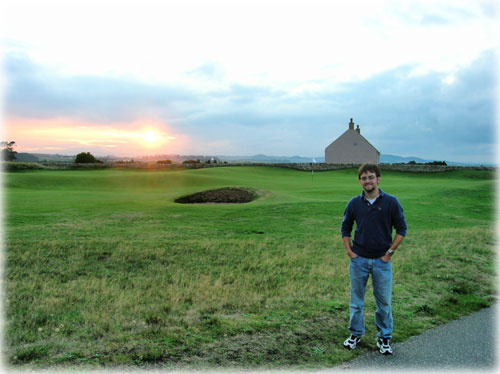 by Preston MacDougall September 29, 2006
My recent trip to St. Andrews, Scotland, had just such a purpose, and no shortage of daunting. I've been through this before, but at another prestigious university. Still, during the university principal's welcoming address for parents, I was ready for a feeling of déjà vu. I was expecting to be told of its envied reputation and storied history, and was. Rather than news, these were the reasons I was there.  receives some fatherly advice about "avoiding sand traps." Photograph by Preston MacDougall One thing did surprise me though. After suggesting that parents look carefully around the room, Principal Lang, who is a social anthropologist by training, cited a recent poll showing that, among all British universities, St. Andrews' alumni were the most likely to have met their future spouse during their course of study. So "match play" is not limited to the links when the British Amateur Championship comes to the Old Course in St. Andrews. Being the curious chemist that I am, I couldn't help looking around the room. Chemists don't have a monopoly on curiosity, and it was obvious that others were looking at me too. It was then that I had an epiphany of sorts: university administrators are becoming matchmakers. I am not talking about pairing-up students - Facebook does that. No, I'm talking about pairing-up faculty. Last year, I visited the University of Western Australia in Perth, where they had just moved into a sparkling new $60 million building serving the needs of faculty in both the biological and the chemical sciences. Then, just before my trip to Scotland, I learned the exciting news that the State of Tennessee was willing to spend over $100 million to build a new science building that would be big enough to house both the departments of biology and chemistry at Middle Tennessee State University. And finally, since I was going to be in St. Andrews anyway, I offered to give a seminar on my molecular visualization research for their chemistry department. If you are having difficulty forming a mental image of this, imagine a proud father giving a slide presentation featuring his progeny, for over an hour, and you get the picture. Thankfully, nobody fell asleep. Not even me, which was a distinct possibility since I had just got off the plane after an overnight flight without a wink of sleep. After the presentation, my host, Professor Derek Woollins, who is Director of Research for the School of Chemistry, took my son and me on a tour of the old and new chemistry facilities. The elder, the Purdie Building, has served the uni well. While the refrigerators and fume hoods in its laboratories contain evidence of challenging, wee molecular artwork, in various stages of construction by their student forgers, the Purdie does look its age. It is currently undergoing some well-earned renovations. Adjacent to the Purdie, the profile of the new building was designed to call forth the image of a sailing ship. It is the home of the new Centre for Biomolecular Sciences along with its entering class of 15 research groups from the schools of chemistry and biology. During the tour, Professor Woollins explained that while some floors were populated exclusively by chemists or biologists, other floors were designed to mix them. Have you caught on to the matchmaking? Since buildings as expensive as these do not get built without the blessing of administrators and politicians, you might be wondering what kind of hanky-panky has their tacit approval. Here's my guess. The thinking must be that inter-breeding of biology and chemistry will produce plenty of offspring. Namely, biotech and pharmaceutical patent royalties. Patents don't get me as excited as new ideas do, and I see many of these as well in the future of science buildings that are adventurously inter-disciplinary. Think of them as co-educational in another sense. Conventional science is hazardous enough. Experiments often end up in the rough. And without continually learning new things, scientists can get trapped in a bunker mentality. Co-ed science won't be any less risky, but it just might be more fun. I imagine a familiar sound, but emanating from the labs of St. Andrews when chemists and biologists try new experiments together - Fore!
On the Web:
Publish A Letter on SitNews Read Letters/Opinions Submit A Letter to the Editor
|